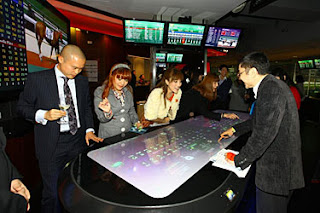Happy Valley, Hong Kong Style
Fans of American Rules Football would more readily equate the name "Happy Valley" with some remote backwater college town in the untamed wilderness of Pennsylvania. Aficionados of The Sport of Kings are more likely associate "Happy Valley" with the venerable Hong Kong Jockey Club, founded in 1884. In 1959 Queen Elizabeth II granted the HKJC a royal charter which it retained until Hong Kong itself was handed over to the ChiComms in 1997.
[Click on the photos in order to see them all in their super-sized glory.]
That is quite a contrast from how the race track, and Happy Valley itself, looked in 1873:
I am old school in most things. This certainly applies to my preference for daytime horse racing; For historical continuity, for aesthetics and for evolutionary science - horses are naturally more active in daylight and, like humans, tend to seek shelter and quiet rest when the sun sets. That said, Happy Valley does present one of the few settings wherein nighttime racing provides patrons with a picturesque scene:
The Hong Kong skyline is right there!
This assuredly is different from backdrops to which we in the United States are more accustomed - the gently rolling parkland hills of central Kentucky (Keeneland) or the mountains of southern California (Santa Anita) or the forested woodlands of upstate New York (Saratoga). This is horse racing for the population explosion apocalypse.
The reason for this specific feature on the HKJC, however, has to do with recently introduced technological advances in wagering which first made their debut in Happy Valley in 2012 (or, in China, 4709; The year of the Water Dragon). The touch screen/tablet revolution now has a beachhead in Happy Valley that provides patrons with a way of wagering which may more closely resemble the chess board on the Millennium Falcon or those early-1980s tabletop versions of Pac-Man than the old-fashioned betting windows of yore.
No, that's not a studio set for the forthcoming Star Wars Episode VII; Sith Lord C-3PO. That is the Happy Valley race book. We're not at Turfway Park anymore, Toto!
And no, those are not aliens in the Tattooine cantina. Those are 21st century ChiComms (or 48th century, depending upon on your calendar) at Happy Valley wagering on a multi-configurable tabletop touch screen display, tossing out Mao's Little Red Book and throwing down thousands of dollars in U.S. securitized debt on a 17-to-1 longshot in the fifth named Taiwan Rolex Invasion Fun.
Can I get Pac-Man on this thing?
And no, I did not seek prior written approval from the Office of the Commissioner of Major League Baseball for ripping the Hong Kong Jockey Club photos off the interweb. Take that you copyright-infringing ChiComms!
Long-range Reconnaissance
That panoramic photo is of the Polo Grounds from August 13, 1904. On that afternoon, the John McGraw-Christy Mathewson New York Giants hosted the mighty Cincinnati Reds of Noodles Hahn and Cy Seymour acclaim. According to baseball-reference.com, the Redlegs beat the Giants, 2-1.
Below you will find a better-quality photo of the Polo Grounds:
Below you will find a better-quality photo of the Polo Grounds:
This photo is of Game 5 of the 1905 World Series, the New York Giants hosting the Philadelphia Athletics. This World Series produced the single-greatest World Series pitching performance in the history of baseball when Giants' ace Christy "Big Six" Mathewson pitched and won three complete game shutouts, winning 4-hit shutouts in Game 1 and Game 3 (both played on the road in Philadelphia) and then clinching the championship for New York with a 5-hit shutout in Game 5 at the Polo Grounds (above). According to baseball-reference.com, the paid attendance for Game 5 was 24,187. This does not include the hundreds or thousands which were watching from Coogan's Bluff, seen high above the Polo Grounds' grandstand. For a sense of the perspective these fans would have had, check out the photo of Coogan's Bluff at Wikipedia.com, linked below:
What I most like in the photo from the 1905 World Series is the cultural/technological transition reflected in the mix of personal transport parked in the outfield (in the Dead Ball Era, the outfield fences were so far distant from home plate that batters had no hope of hitting a baseball into the outer reaches of the playing field); Mostly horse-drawn carriages but with a handful of so-called horseless carriages too.








No comments:
Post a Comment